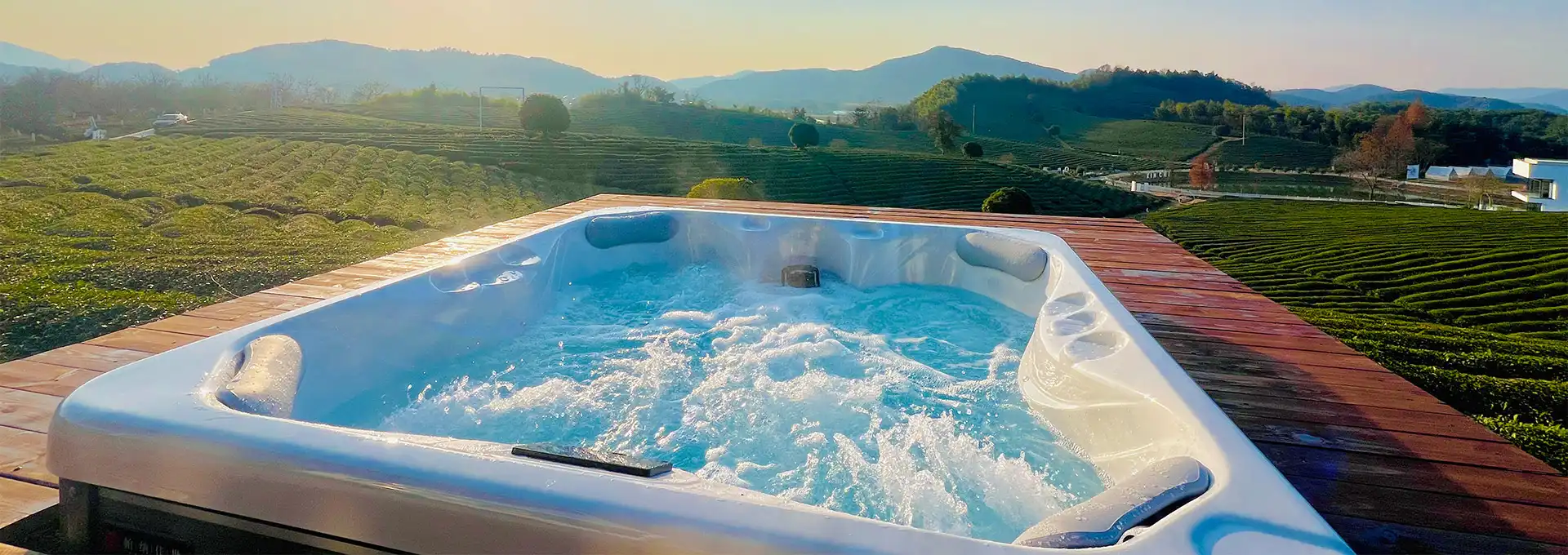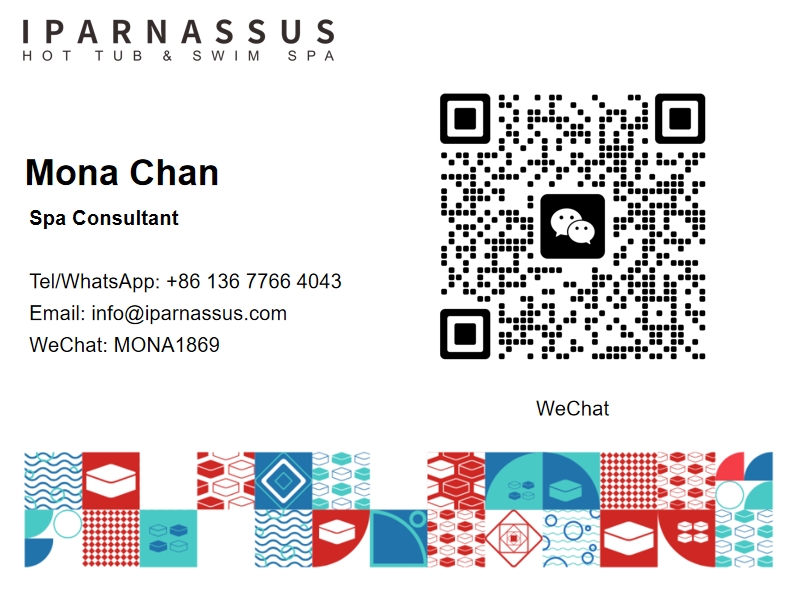Can Hotel Hot Tubs in the Middle East Withstand the Heat and Water Scarcity?
2024-12-19 16:56:55
The Middle East's luxury hotel industry faces unique challenges in maintaining premium amenities like hot tubs. With temperatures regularly soaring above 40°C (104°F) and water being a precious resource, hotels must carefully consider their hot tub installations. This comprehensive analysis explores how modern hot tub solutions are adapting to meet these challenging environmental conditions while maintaining the high standards expected by luxury hotel guests.
Shenzhen Iparnassus Intelligent Spas Co., LTD specializes in resort hot tubs and infinity pool spas. Our hot tubs feature circulation filtration and sterilization systems, reducing the need for frequent water changes. With a professional team handling design, R&D, production, sales, and after-sales service, we've secured over 30 patents as of 2023. The iParnassus® brand operates in dozens of countries globally. For Middle Eastern hotel bulk purchase cooperation: 1. Free custom mold support; 2. Free control system upgrade with hotel centralized management system; 3. Direct cooperation with top manufacturers, providing direct benefits to hotels; 4. North American materials and standards at competitive prices. Our premium products and reliable after-sales service reach over 20 countries worldwide. Contact info@iparnassus.com for more information.
What Temperature Can a Hotel Hot Tub Safely Operate In?
In the demanding climate of the Middle East, where summer temperatures routinely soar beyond 45°C (113°F), the engineering and operational requirements for hotel hot tubs present unique challenges that necessitate sophisticated solutions. Modern hot tub design has evolved significantly to address these extreme conditions through a comprehensive integration of advanced materials and innovative engineering approaches.
Manufacturers have developed specialized light-colored aluminum-plastic composite panels that serve as the primary external structure, demonstrating remarkable resilience by maintaining structural integrity in temperatures ranging from 50°C to 70°C. The tubs themselves feature state-of-the-art acrylic surfaces, specifically engineered to withstand sustained exposure to temperatures between 70°C and 80°C without compromising their structural integrity or aesthetic appeal. Essential to the overall system are the light-colored insulation covers, which play a crucial role in thermal management by effectively isolating temperature extremes and preventing excessive heat absorption. The incorporation of UV-resistant materials throughout the construction addresses the intense solar radiation characteristic of the region, ensuring long-term durability by preventing material degradation and maintaining the aesthetic qualities of the installation. Double-wall insulation systems represent another critical engineering advancement, enabling precise control over water temperatures while minimizing the impact of extreme external conditions.
The practical success of these technological solutions is evidenced by their widespread implementation across luxury hotels and resorts throughout Dubai, Saudi Arabia, and neighboring Gulf states, where hot tubs operate reliably year-round despite the challenging environmental conditions. This real-world validation demonstrates how the careful application of materials science and engineering principles has effectively overcome the substantial challenges posed by extreme Middle Eastern temperatures, ensuring that hotel guests can enjoy these amenities regardless of external weather conditions.
How Do Hotel Hot Tubs Handle Water Conservation in Arid Regions?
In regions where water scarcity poses significant challenges, particularly across the Middle East, hotels have adapted their hot tub operations through sophisticated water management strategies that balance luxury amenities with environmental responsibility. Modern hot tub systems incorporate cutting-edge filtration technology that fundamentally transforms how water is maintained and conserved. These systems utilize a comprehensive multi-stage filtration process capable of removing particles as small as 1 micron, ensuring exceptional water clarity while maximizing water reuse potential. The integration of UV sterilization technology has proven particularly revolutionary, effectively eliminating 99.9% of harmful bacteria without requiring additional chemical treatments.
This is further enhanced by ozone treatment systems, which provide a chemical-free approach to sanitization, significantly reducing the need for traditional water treatment chemicals while maintaining the highest hygiene standards. Real-time smart monitoring systems continuously analyze water quality parameters, allowing for precise and timely adjustments that optimize both water conservation and guest safety. Hotels have also implemented sophisticated water conservation features that work in concert with these filtration systems. Automated water level controls prevent wasteful overflow scenarios, while enhanced evaporation prevention systems significantly reduce water loss in arid climates. The implementation of water recycling capabilities has created closed-loop systems that dramatically improve sustainability metrics, and smart scheduling algorithms ensure maintenance and cleaning operations occur at optimal intervals to minimize water usage.
These technological innovations have yielded impressive results, with many facilities reporting water savings of up to 30% compared to conventional hot tub systems, while simultaneously maintaining or even improving upon traditional hygiene standards. This comprehensive approach to water management demonstrates how luxury hospitality can adapt to environmental constraints without compromising the guest experience, setting new benchmarks for sustainable operation in water-stressed regions.
What Maintenance Requirements Do Hotel Hot Tubs Have in Desert Environments?
Hotel hot tubs in desert environments require meticulous maintenance protocols to ensure optimal performance and guest satisfaction while combating unique environmental challenges. The harsh desert climate, characterized by extreme temperatures, abundant sand and dust, and high mineral content in water supplies, necessitates a comprehensive approach to maintenance that goes beyond standard protocols used in more temperate regions.
Daily maintenance forms the foundation of desert hot tub care, encompassing rigorous water chemistry testing and adjustment to combat rapid evaporation and mineral buildup. Maintenance staff must vigilantly inspect and clean filters, as desert dust and sand can quickly compromise filtration efficiency. Surface cleaning becomes particularly critical, as wind-blown particles can accumulate rapidly, potentially damaging surfaces and components while detracting from the guest experience. Protective covers must be regularly cleaned and maintained to prevent sand infiltration and reduce evaporation losses.
Weekly maintenance procedures delve deeper into system care, incorporating thorough filter cleaning protocols specifically designed for desert conditions. These sessions include comprehensive system performance evaluations to identify any early signs of stress or wear from extreme temperature fluctuations and environmental factors. Water quality analysis becomes more detailed during weekly checks, with particular attention paid to mineral content and scaling potential. Equipment inspections focus on components most vulnerable to desert conditions, such as heating elements and pump seals.
Monthly maintenance elevates care to a more comprehensive level, bringing in professional service technicians to conduct detailed system evaluations. These specialists assess component durability with particular attention to materials exposed to intense desert conditions. Water conservation audits take on special significance in desert regions, where water resources are often scarce and expensive. These monthly reviews also provide opportunities to evaluate and adjust maintenance protocols based on observed patterns and emerging challenges.
Modern technology has revolutionized desert hot tub maintenance through the integration of smart systems that enhance efficiency and reliability. Remote monitoring capabilities allow for real-time tracking of crucial parameters, while automated chemical balancing systems maintain optimal water chemistry despite rapid evaporation rates. Sophisticated early warning systems can detect potential issues before they become critical, enabling proactive maintenance interventions. Performance optimization algorithms continuously adjust system operations to maximize efficiency while minimizing resource consumption, particularly important in desert environments where operating costs can be significantly higher.
The hospitality industry in desert regions, particularly in the Middle East, continues to refine its approach to hot tub installations and maintenance. Properties are increasingly investing in advanced materials specifically engineered to withstand desert conditions, such as UV-resistant surfaces and enhanced filtration systems. Water conservation technologies have become paramount, with properties implementing sophisticated recycling systems and efficient water treatment processes. Smart maintenance systems are being integrated into broader property management platforms, allowing for more coordinated and efficient operations while maintaining the highest standards of water quality and guest comfort.
The successful operation of hotel hot tubs in desert environments ultimately depends on the careful balance of multiple factors: rigorous maintenance protocols, appropriate technology implementation, and a deep understanding of local environmental challenges. Properties that master this balance can offer their guests a luxurious amenity while maintaining operational efficiency and environmental responsibility, even in the most challenging desert conditions.
For more information on hot tub installations and our products, please feel free to contact us at info@iparnassus.com.
References:
1. International Journal of Hospitality Management (2023). "Water Conservation in Luxury Hotels: Middle East Case Studies"
2. Hotel Management International (2024). "Sustainable Spa Technologies in Arid Climates"
3. Middle East Tourism and Hospitality Research (2023). "Luxury Amenities in Desert Hotels"
4. Journal of Sustainable Tourism (2023). "Water Management in Middle Eastern Hotels"
5. International Water Resources Association (2024). "Water Conservation in Hospitality Industry"
Send Inquiry
Related Industry Knowledge
- Can a Frozen Hot Tub Be Repaired?
- What Happens When a Swim Spa Loses Heat?
- What Swim Spa Should I Buy?
- Is a Swim Spa Worth the Investment Compared to Traditional Pools and Hot Tubs?
- Why is a Receptacle Required for Outdoor Hot Tubs?
- Can you do water therapy in a hot tub?
- Can a Hot Tub Stay Out in Winter?
- How to Tell If Hot Tub Fuse is Blown?
- How many gallons does a 5 person hot tub hold?
- How much does a 4 person hot tub weigh?



